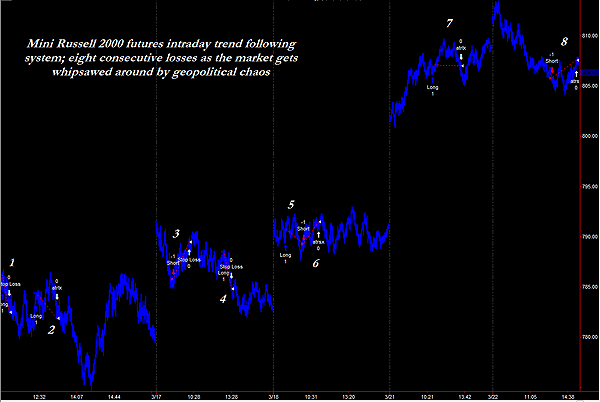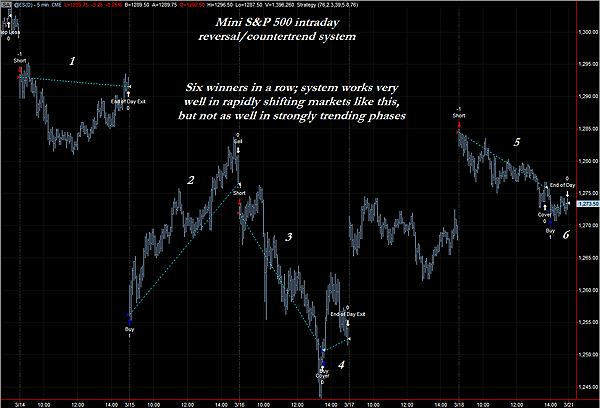
HOT TOPICS LIST
- MACD
- Fibonacci
- RSI
- Gann
- ADXR
- Stochastics
- Volume
- Triangles
- Futures
- Cycles
- Volatility
- ZIGZAG
- MESA
- Retracement
- Aroon
INDICATORS LIST
LIST OF TOPICS
PRINT THIS ARTICLE
by Donald W. Pendergast, Jr.
When markets trend strongly, some systems really earn their keep. But what about having a system to rely on for those more frequent occurrences of consolidation, sideways chop, and generalized market chaos?
Position: N/A
Donald W. Pendergast, Jr.
Donald W. Pendergast is a financial markets consultant who offers specialized services to stock brokers and high net worth individuals who seek a better bottom line for their portfolios.
PRINT THIS ARTICLE
TRADING SYSTEMS
Trends Versus Consolidations, A System View
03/23/11 08:41:21 AMby Donald W. Pendergast, Jr.
When markets trend strongly, some systems really earn their keep. But what about having a system to rely on for those more frequent occurrences of consolidation, sideways chop, and generalized market chaos?
Position: N/A
| Imagine: eight losing trades in a row from an intraday trend-following system. Surely there must be a mistake -- the system's doubtlessly gone haywire! Now picture another hypothetical system's performance results, one that just had six winning trades in a row because it was able to adapt to and/or time the sharp intraday reversals seen lately in the Standard & Poor's 500. Here are those pictures, starting with the hypothetical trend-following system. |

|
| FIGURE 1: EIGHT IS ENOUGH. This hypothetical system can really chalk up the points when the Russell 200 index goes on a sustained multiday tear, but it tends to lose when the market can't quite figure out what it wants to do from day to day. |
| Graphic provided by: TradeStation. |
| |
| The chaos in the geopolitical scene over the past month has been merciless to this particular emini Russell 2000 futures trading system (see Figure 1). It attempts to profit from sustained intraday surges in that particular index and actually did quite well in five months of hypothetical forward-testing. Since late February, however, the system has had a 16% drawdown and looks about as attractive as a dead skunk on the side of the road. Will it ever get going again, piling on profits fast enough to overcome these losses before going on to even bigger gains? No one knows. What is known is that sometimes a good system goes bad due to changing market conditions, maladaptive system logic, and so on. It's also known that it's a good idea to trade multiple systems over multiple markets (if your futures margin account is large enough) so that you can afford yourself the best chance of making money on a consistent basis, regardless of underperformance issues in a given system. With that in mind, here's the chart of an intraday emini S&P 500 futures trading system, one based on a countertrend/reversal logic rather than a trend-following logic. See Figure 2. |

|
| FIGURE 2: MINI S&P 500. Meanwhile, this particular hypothetical system seems to adapt very well to the typical knee-jerk kinds of intraday movements typically seen in the mini S&P futures contract. Perhaps it might be a good idea to combine both a trend-following system and a reversal system into your futures trading portfolio. |
| Graphic provided by: TradeStation. |
| |
| Obviously, this system is far more in tune with the price action in the mini S&P than the trend-following system has been in the mini Russell. There are a couple of reasons for this, one of which is that the mini S&P is more of a "stop and reverse" market than the mini Russell is, due to a great deal of intermarket arbitrage activity, option hedging (see Austin Passamonte's excellent article concerning the Russell 2000 futures market from the November 2010 issue of STOCKS & COMMODITIES) and other kinds of news-driven trading activity that seem to limit the big indexes ability to trend substantially. When the mini S&P starts chopping around like this, that's when this system shines. Obviously, it doesn't do as well during mini S&P trend moves, although it can and does seem able to lock on to reversals that turn into big winners from time to time. |
| Although it isn't a simple process, a shrewd trader would investigate ways that he could allocate more or less capital to either of these systems, depending on how well (or poorly) either of them might be doing at any given time. Here are a few ideas on how that might be approached: 1. Utilize moving average crossovers of the each system's equity curve. When one system starts to lag, stop trading it and stay with the other system for as long as it is outperforming. 2. Trade both systems as if they were one system, for equity curve purposes. You could even add a moving average for the combined system equity curve. 3. Create an external volatility filter that will cause you to stop trading the trend-following system when markets get extremely chaotic and directionless, while enabling you to keep trading the reversal systems in those same kinds of fast-changing markets. Remember to account for the differences in contract values and margin requirements as you formulate all of this so that you don't end up overweight (or underweight) on any given system. You'll need to do a great deal of research, testing, and then more testing to properly implement all of this, but if you can manage to do it, your system trading experience might prove to be very much enhanced. |
Donald W. Pendergast is a financial markets consultant who offers specialized services to stock brokers and high net worth individuals who seek a better bottom line for their portfolios.
| Title: | Writer, market consultant |
| Company: | Linear Trading Systems LLC |
| Jacksonville, FL 32217 | |
| Phone # for sales: | 904-239-9564 |
| E-mail address: | lineartradingsys@gmail.com |
Traders' Resource Links | |
| Linear Trading Systems LLC has not added any product or service information to TRADERS' RESOURCE. | |
Click here for more information about our publications!
PRINT THIS ARTICLE

|

Request Information From Our Sponsors
- StockCharts.com, Inc.
- Candle Patterns
- Candlestick Charting Explained
- Intermarket Technical Analysis
- John Murphy on Chart Analysis
- John Murphy's Chart Pattern Recognition
- John Murphy's Market Message
- MurphyExplainsMarketAnalysis-Intermarket Analysis
- MurphyExplainsMarketAnalysis-Visual Analysis
- StockCharts.com
- Technical Analysis of the Financial Markets
- The Visual Investor
- VectorVest, Inc.
- Executive Premier Workshop
- One-Day Options Course
- OptionsPro
- Retirement Income Workshop
- Sure-Fire Trading Systems (VectorVest, Inc.)
- Trading as a Business Workshop
- VectorVest 7 EOD
- VectorVest 7 RealTime/IntraDay
- VectorVest AutoTester
- VectorVest Educational Services
- VectorVest OnLine
- VectorVest Options Analyzer
- VectorVest ProGraphics v6.0
- VectorVest ProTrader 7
- VectorVest RealTime Derby Tool
- VectorVest Simulator
- VectorVest Variator
- VectorVest Watchdog
